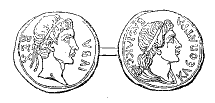Ptolemy of Mauretania
Ptolemy was most probably born in Caesaria, the capital of the Kingdom of Mauretania (modern Cherchell, Algeria) in the Roman Empire.In choosing her son's name, Cleopatra Selene II created a distinct Greek-Egyptian tone and emphasized her role as the monarch who would continue the Ptolemaic dynasty.He was part of the remarkable court of his maternal aunt Antonia Minor, an influential aristocrat who presided over a circle of various princes and princesses which assisted in the political preservation of the Roman Empire's borders and affairs of the client states.During his co-rule with Juba II, and into his sole rule, Ptolemy, like his father, appeared to be a patron of art, learning, literature and sports.In the year 17, the local Berber tribes, the Numidian Tacfarinas and Garamantes, started to revolt against the Kingdom of Mauretania and Rome.The war reached the point where Ptolemy summoned the Roman governor of Africa, Publius Cornelius Dolabella, and his army to assist him in ending the revolt.He was a popular monarch with the Berbers and had travelled extensively throughout the Roman Empire, including Alexandria, Egypt and Ostia, Italy.According to inscription evidence, Ptolemy may have established a Royal Mauretanian cult honoring himself and his late parents (see Berber mythology).Evidence suggesting that Ptolemy could have deified Juba II after his death is from the writings of the Christian author of the 3rd century, Marcus Minucius Felix.Further literary evidence, suggesting the deification of Juba II by Ptolemy, is from the brief euhemerist exercise entitled On the Vanity of Idols by the 3rd-century Christian saint Cyprian.In his exercise in deflating the gods, Cyprian observed and stated that the Mauretanians were manifestly worshiping their kings and did not conceal their name by any disguise.A rare revealing gold coin, dated from the year 39, celebrates Ptolemy's ascent, his rule, and his loyalty to Rome.Through his father's central bust and inscription, Ptolemy is celebrating and showing the continuation of his family and rule, while honoring his paternal ancestry.He appears in Stephanie Dray's novel Daughters of the Nile, which marked the end of the trilogy focusing on Ptolemy's mother.His sculpted images are of a youthful appearance, and particularly those first portraits created during the reign of Juba II virtually show his relations to the Julio-Claudian dynasty.There is a seven-inch fine bronze Roman imperial bust of Ptolemy about age 15 which Sotheby's auctioned in New York for $960,000 in 2004.




LouvreKing of MauretaniaJuba IIRoyal Mausoleum of MauretaniaDrusillaNumidiaPtolemaic dynastyCleopatra Selene II of EgyptAncient GreekMauretaniaBerberMassylesCleopatra Selene IINumidianobverseArchaeological Museum of CherchellJuba I of NumidiaBerbersNorth AfricaPompeyPtolemaicCleopatra VIIMark AntonyJulius CaesarJulio-Claudian dynastyGermanicusRoman EmperorClaudiusCaligulaAgrippina the YoungerValeria MessalinaCherchellAlgeriaRoman EmpireRoman citizenshipAntonia MinorAugustusOctavia MinorAthensGreeceVatican MuseumsTacfarinasGaramantesRoman SenateAlexandriaTemple of Saturn frugifer duesconsidered equivalent toHiempsal IIBerber mythologygeniusMarcus Minucius FelixeuhemeristCyprianAncient EgyptianHellenistic periodpharaohcurule chairwreathsceptreroyal family of EmesaAedemonGnaeus Hosidius GetaGaius Suetonius PaulinusMauretania TingitanaMauretania CaesariensisRobert GravesI ClaudiusMoroccoSotheby'sNew YorkRolfe, John CarewTacitusEncyclopædia BritannicaUniversity of Oklahoma PressJohn Peter Oleson